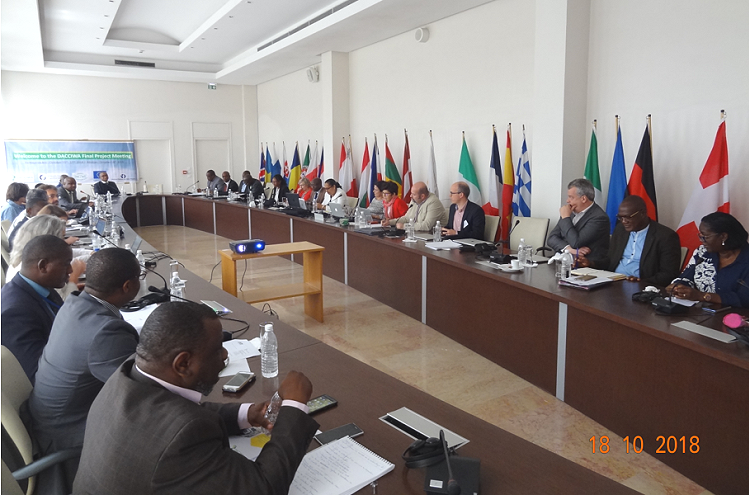The politics of air pollution in Africa
| Figure: Presentation of the policy relevant results from the DACCIWA project at the EU Delegation in Abidjan Ivory Coast on 18 October 2016. Besides the project scientists, there are representatives of Ivorian ministries and other organisations as well as of European embassies on the photo. The event was covered in the evening news on national TV (https://youtu.be/aa_kyanvUOQ, about minute 20). |
The population in Africa is the fastest growing in the world. Particularly in southern West Africa, the combination of population increase, urbanisation and economic growth has led to a projected tripling of manmade emissions of pollutants between 2000 and 2030. The DACCIWA (Dynamics-Aerosol-Chemistry-Cloud Interactions in West Africa) project is the first to investigate the magnitude of the air pollution problem and its impacts on human health and weather and climate in the region. DACCIWA is coordinated by Prof Peter Knippertz, leader of IMK-TRO’s Working Group “Atmospheric Dynamics”. The EU-funded consortium consists of 18 European and African research institutions.
After five years of intense research, DACCIWA will come to an end in November 2018. “It is therefore time for us to summarise results of our great research”, says Knippertz, “and to communicate the main findings to stakeholders and policymakers”. This is done through a series of workshops in three West African capitals (Accra on 12 October, Abidjan on 18 October and Lomé on 19 October) and in Brussels (15 November). Additionally, the key conclusions and recommendations are written up in English and French in a Policy Brief document that will be freely available through the project’s website www.dacciwa.eu.
Given the general sparsity of atmospheric observations in Africa, a key to the significant scientific advances DACCIWA made was a major international field campaign in June-July 2016 in Ivory Coast, Ghana, Togo, Benin and Nigeria. This campaign consisted of 50 scientific flights with German, French and British research aircraft, three highly instrumented supersites, ca. 770 weather balloon launches from seven different sites and urban measurements in Abidjan and Cotonou.
With respect to air pollution, DACCIWA scientists found that concentrations of small particles frequently exceed international standards in West African cities, causing significant respiratory and heart diseases. During the dry season, particles come from city emissions (mostly traffic, domestic and waste burning), agricultural fires and mineral dust from the Sahara, leading to the highest overall concentrations. In the wet season, city emissions increase due to the use of damper wood and charcoal and there is a significant import of smoke from the extensive forest and agricultural fires in central Africa. Ways to mitigate this problem include a move to gas and electricity for domestic cooking, regulations for biomass burning and a reduction of the sulphur content in fuels for vehicles. “Through DACCIWA we realised that air pollution in Africa is a trans-boundary problem”, says Knippertz, “and cannot be solved by one country alone.”
DACCIWA also discovered impacts of the increased particle concentrations on weather and climate. While cloud properties appear to be affected only marginally, the reduction of sunlight reaching the ground in a hazy atmosphere affects the coastal circulation, the daily cycle of clouds and possibly rainfall.
DACCIWA scientists also used the policy workshops to make a strong plea to improve the availability and accessibility of data for research. This includes not only air pollution and meteorological parameters but also socio-economic and emission data as well as health statistics.
[Working group: Atmospheric Dynamics]

